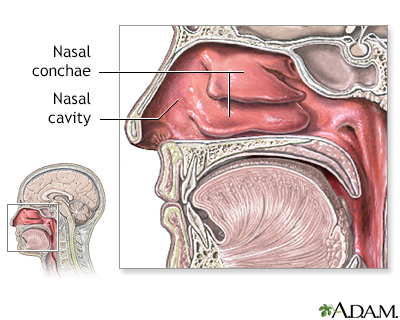Foreign body in the nose
Definition
This article discusses first aid for a foreign object placed into the nose.
Alternative Names
Something stuck in the nose; Objects in the nose
Considerations
Curious young children may insert small objects into their nose in a normal attempt to explore their own bodies. Objects placed in the nose may include food, seeds, dried beans, small toys (such as marbles), crayon pieces, erasers, paper wads, cotton, beads, button batteries, and disc magnets.
A foreign body in a child's nose can be there for a while without a parent being aware of the problem. The object may only be discovered when visiting a health care provider to find the cause of irritation, bleeding, infection, or difficulty breathing.
Symptoms
Symptoms that your child may have a foreign body in his or her nose include:
- Difficulty breathing through the affected nostril
- Feeling of something in the nose
- Foul-smelling or bloody nasal discharge
- Irritability, particularly in infants
- Irritation or pain in the nose
Patient Education Video: What to do when kids put things in their nose
First Aid
First aid steps include:
- Have the person breathe through the mouth. The person should not breathe in sharply. This may force the object in further.
- Gently press and close the nostril that does NOT have the object in it. Ask the person to blow gently. This may help push the object out. Avoid blowing the nose too hard or repeatedly.
- If this method fails, get medical help.
Do Not
- DO NOT search the nose with cotton swabs or other tools. This may push the object further into the nose.
- DO NOT use tweezers or other tools to remove an object that is stuck deep inside the nose.
- DO NOT try to remove an object that you cannot see or one that is not easy to grasp. This can push the object farther in or cause damage.
When to Contact a Medical Professional
Get medical help right away for any of the following:
- The person cannot breathe well
- Bleeding occurs and continues for more than 2 or 3 minutes after you remove the foreign object, despite placing gentle pressure on the nose
- An object is stuck in both nostrils
- You cannot easily remove a foreign object from the person's nose
- The object is sharp, is a button battery, or two paired disc magnets (one in each nostril)
- You think an infection has developed in the nostril where the object is stuck
Prevention
Prevention measures may include:
- Cut food into appropriate sizes for small children.
- Discourage talking, laughing, or playing while food is in the mouth.
- Do not give foods such as hot dogs, whole grapes, nuts, popcorn, or hard candy to children under age 3.
- Keep small objects out of the reach of young children.
- Teach children to avoid placing foreign objects into their noses and other body openings.
Gallery

References
Chi DH, Tobey A. Otolaryngology. In: Zitelli BJ, McIntire SC, Nowalk AJ, Garrison J, eds. Zitelli and Davis' Atlas of Pediatric Physical Diagnosis. 8th ed. Philadelphia, PA: Elsevier; 2023:chap 24.
Haynes JH, Zeringue M. Removal of foreign bodies for the ear and nose. In: Fowler GC, ed. Pfenninger and Fowler's Procedures for Primary Care. 4th ed. Philadelphia, PA: Elsevier; 2020:chap 204.
Thomas SH, Goodloe JM. Foreign bodies. In: Walls RM, Hockberger RS, Gausche-Hill M, eds. Rosen's Emergency Medicine: Concepts and Clinical Practice. 9th ed. Philadelphia, PA: Elsevier; 2018:chap 53.
